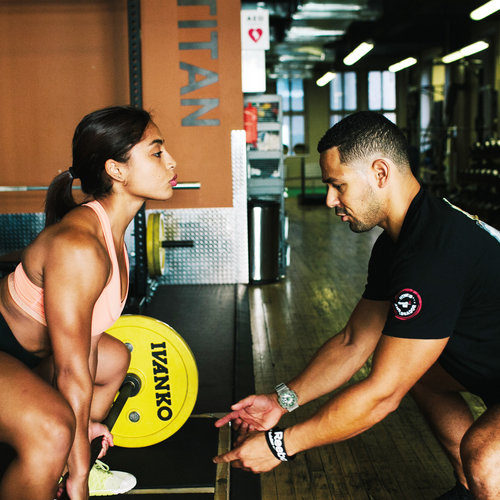Verbal cues are an important aspect in the training, development, and overall success of athletes both on and off the platform/field/competitive arena. It has been shown that verbal instructions play a central role in motor learning and performance, with distinguished differences between the styles of verbal cues. External and internal cues have been used by coaches and other training partners to motivate and promote intended outcomes across many sporting movements and lifts. Coaches and athletes should have a deeper understanding of the differences between external and internal coaching cues and how to correctly use them to produce performance improvements.

In this article, we will review the literature to discuss, compare, and analyze the effectiveness of external and internal cues in relationship to the training and coaching of weightlifting, powerlifting, and other fitness athletes.
Explaining Internal vs. External Cues
Verbal Cues are often used by coaches to instruct athletes to focus on a desired outcome. Cues, unlike instructions, are often 1-2 words in length, and begin with an adjective, such as; drive, push, explode, pull, etc and can be used as a mantra by athletes during training and competition.
Internal focus of attention cues (IFAC) are specific instructions that direct an athlete’s/lifter’s attention towards a specific bodily movement and/or muscle action. IFAC has been shown to be a less effective verbal coaching method in complex movements, such as jumping, sprinting, and resistance training. It has been suggested that the sole focus on one specific component (joint action or movement) may hinder overall performance and integration of all muscle groups and movements involved in complex movements.
External focus of attention cues (EFAC) are specific instructions that direct an athlete’s/lifter’s attention towards the intended movement outcome, often placing focus on an external object related to the outcome task. EFAC has been shown to improve jump, spring, throwing, golf, and resistance training performance in complex movements by allowing the organization of all the components of a complex movement automatically, without omitting any other components.
Here is what science tells us about the significant differences between IFAC versus EFAC.
- Significant improvements in overall maximal force output performance have been reported when EFAC was given when compared to both placebo (-3%) and IFAC (-9%) groups in motivated athletes, which supported previous findings of improved jump performance muscular endurance when using EFAC vs IFAC.
- EFAC has been shown to increase motor development and learning rate in beginners in complex movements when compared to IFAC.
- EFAC has been shown to decrease the perceived difficulty and rate of exertion of a physical task in athletes when compared to IFAC.
- “The Constrained Action Hypothesis” proposes that EFAC promote an automatic motor response that is in line with the desired income, whereas the IFAC restricts automatic motor responsiveness by directing athletes to focus on one specific movement/joint during a complex movement that is otherwise performed through the integration of multiple muscles and joints.
- IFAC has been shown to have greater EMG muscle activity than EFAC. That same decreased EMG site specific muscle activity has been thought to relax antagonist muscle groups that may hinder synchronization of muscle groups in more complex movements.
Real-World Examples
Below are examples of both internal and external cues, listed in corresponding order.
Here are some examples of IFAC:
- “Knees Out”: Cue for squatting to prevent knees collapsing.
- “Legs”: Cue for split jerk.
- “High Elbows”: Cue for finishing 3rd pull in snatch.
- “Tight Stomach”: Cue for bracing during lifts
Here are some examples of EFAC:
- “Spread the Floor”: Cue for squatting to prevent knees collapsing.
- “Dip and Drive”: Cue for split jerk.
- “Throw the Bar Overhead”: Cue for finishing 3rd pull in snatch.
- “Brace Hard”: Cue for bracing during lift.
Final Thoughts
Coaches, training partners, and athletes should examine their verbal cues and communication during training sessions and competition to fully maximize performance. Understanding the differences between internal and external cues, and the correct usage of each may lead to significant improvements strength, power, and athletic performance. Despite EFAC overwhelming research suggesting the effectiveness during complex movement task, IFAC has been shown to have some application, potentially during corrective and hypertrophy training due to increased EMG muscle activity.
Coaches should determine the best ways to incorporate EFAC and IFAC to better instruct and coach beginner and seasoned athletes in complex motor tasks and administer corrective and hypertrophy training.
Editors note: This article is an op-ed. The views expressed herein are the authors and don’t necessarily reflect the views of BarBend. Claims, assertions, opinions, and quotes have been sourced exclusively by the author.
Featured Image: Mike Dewar on J2FIT.com